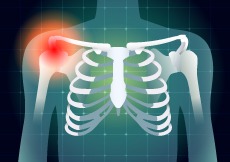Shoulder Socket Fracture Treatment
 A shoulder fracture happens when the center or rim of the socket fractures. This can cause swelling, pain, bruising, and other similar symptoms. Generally, a shoulder fracture occurs due to high-energy impact, such as sports injury, falling from a height, or a car accident.
A shoulder fracture happens when the center or rim of the socket fractures. This can cause swelling, pain, bruising, and other similar symptoms. Generally, a shoulder fracture occurs due to high-energy impact, such as sports injury, falling from a height, or a car accident.
Typically, shoulder fractures are treated using surgical methods. This is because the fractured bone is dislocated and out of place. It needs to be correctly adjusted, which can only be done by way of surgery. The bone will heal incorrectly if it is not placed in the right manner. You may be left with permanent shoulder damage in this case.
Thomas & Bigler Knee and Shoulder Institute, led by board certified orthopedic surgeons Dr. Steven C. Thomas and Dr. Gregory T. Bigler, provides orthopedic surgery to patients in Las Vegas, Nevada, while also serving areas such as greater Pahrump, Bullhead City, Lake Havasu, and Mesquite, NV.
Types of Shoulder Fracture
Shoulder fractures are not common injuries. They may happen because of significant injury to the shoulder, such as a car accident or a high fall. Glenoid fractures can be of two types:
- Glenoid Fossa Fracture: Glenoid fossa is the central part of the socket. It is a far less common fracture and happens when the shoulder sustains extreme trauma. The glenoid fossa breaks in this type of fracture.
- Glenoid Lip Fracture: This happens when the shoulder gets dislocated. The ball of the shoulder socket pushes against the socket rim, resulting in a clean break.
Symptoms of Shoulder Fracture
There are several types of symptoms accompanying shoulder socket fractures:
- Swelling
- Pain
- Difficulty moving the shoulder
- Bruising
- Limited mobility in the shoulder
- Grinding sensation when trying to move the shoulder
Nonsurgical Options for Shoulder Socket Fracture
Nonsurgical treatments generally get the job done when a shoulder socket fracture is not very severe. It will allow you to return to your every day chores. You would need to keep the shoulder in place with a splint, sling, or cast to ensure the bone heals as it should. Depending on the severity of the shoulder socket fracture, your shoulder may heal in a few weeks.
Bone stimulation is another process that helps in speeding up the healing process. The treatment uses low intensity pulsed ultrasound and low electric current. The body gets tricked into believing that there is an injury. It begins producing proteins essential for repairing cells in the injured shoulder.
Surgical Treatments for Shoulder Socket Fracture
The normal contour of the shoulder socket gets restored to prevent recurrent instability or dislocations of the shoulder joint. Often times, surgical treatments are considered for the injuries. This is especially true if the fracture consists of a large fragment of the bone or when the fracture is not aligned in position.
Shoulder socket fractures are highly uncommon, making it difficult to ascertain the ideal treatment. However, most surgeons believe that managing the fracture should depend on the patient’s needs and fracture type. You would be asked to undergo physical therapy as well when the fracture heals.
Orthopedic surgeons Dr. Thomas and Dr. Bigler receive patients from Las Vegas, Nevada as well as greater Pahrump, Bullhead City, Lake Havasu, and Mesquite, NV for orthopedic surgery.
Contact Board Certified Surgeons Dr. Bigler or Dr. Thomas at the Knee and Shoulder Institute in Las Vegas, NV to Schedule an Appointment:
If you would like to schedule an appointment or learn more about the Knee and Shoulder Institute procedures & treatments performed by Las Vegas, Nevada board-certified surgeons Steven C. Thomas, MD and Gregory T. Bigler, MD. Contact the office today click here.
Serving patients from and around greater Las Vegas, Lake Havasu, Bullhead City, Mesquite, Pahrump, Nevada
